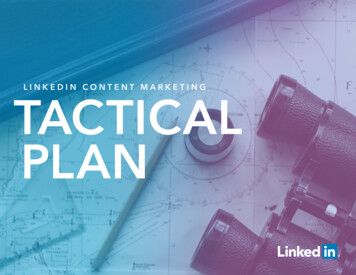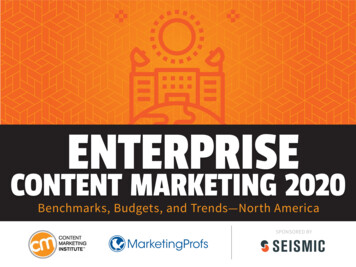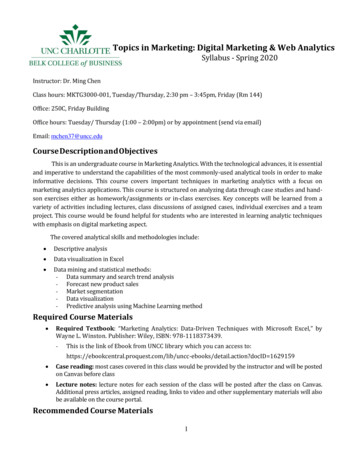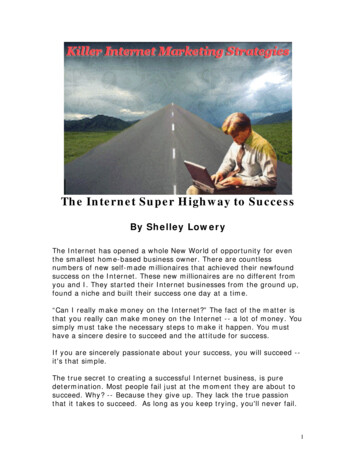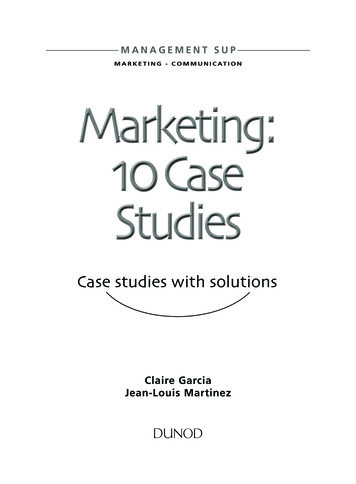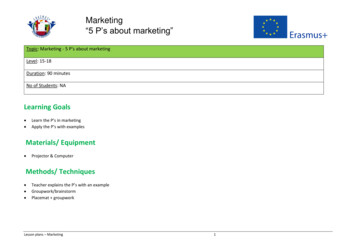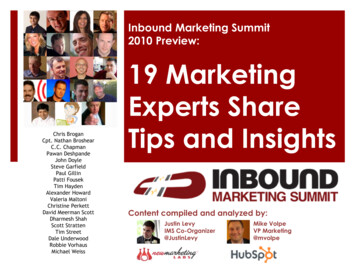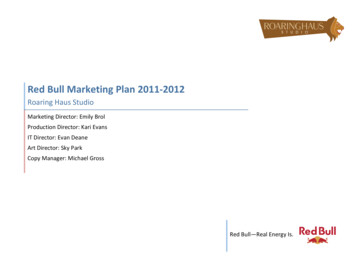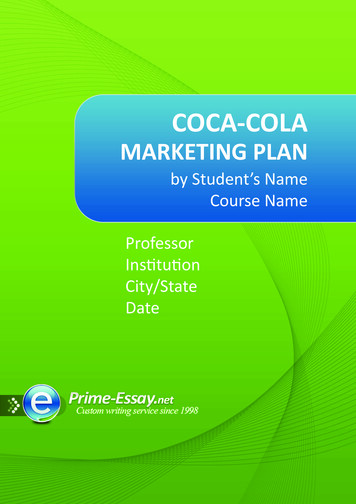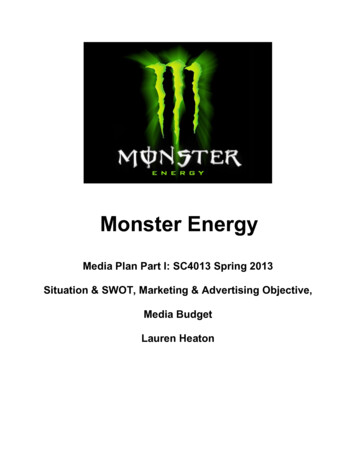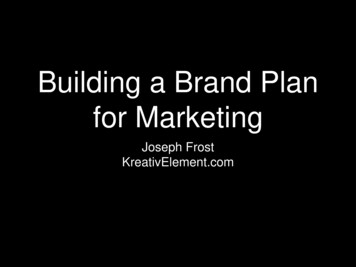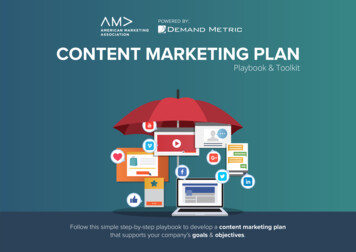
Transcription
CONTENT MARKETING PLANPlaybook & ToolkitFollow this simple step-by-step playbook to develop a content marketing planthat supports your company’s goals & objectives.
Table of ContentsCONTENT MARKETING PLANFramework03Maturity 5stage6Identify ObjectivesUnderstand BuyersIdentify GapsBuild ContentOrganize DistributionMeasure Your Program081113182428Conclusion32About33
CONTENT MARKETINGFrameworkFor more information about the linked resources below,watch the overview videos.Leverage the framework below to quicklyempower your organization’s content marketing strategy.1 OBJECTIVES2 UNDERSTAND3 IDENTIFY4 BUILD5 ORGANIZE6 MEASUREMaturity AssessmentBuyer PersonasAssets DatabaseSales SupportEffectiveness SurveyMarketing ChannelRanking ToolBudget TemplateMaturity ModelCustomer ProfileTemplateWeb Content AuditToolCustomerSatisfaction SurveyLead AcquisitionModelMetrics DashboardBuying Process StageTemplateVendors MatrixMessageMapping ToolMktg AutomationBusiness CasePost ProjectEvaluationWeb Content MgmtSystem RFP TemplatePositioningStatement WorksheetContent MappingTemplateContent Mktg & Distribution System RFPContent QualityChecklistContent MarketingEditorial CalendarWeb Content MgmtVendor EvaluationSEO KeywordDatabaseAgile ContentMarketing CalendarContent Mktg &Distribution VendorContributors DatabaseCase Study TemplateWhite PaperTemplatePress ReleaseTemplate
CONTENT MARKETINGMaturity ModelContentMarketingOrientationSTAGE 1 - UndefinedNo defined strategy or process forContent MarketingSTAGE 2 - ProgressiveDefined strategy and processes existfor Content Marketing in uncoordinatedpocketsSTAGE 3 - MatureDefined, integrated strategy andprocesses exist for Content Marketingacross the EnterpriseSTAGE 4 - World-ClassDefined, integrated strategy forContent Marketing exists across theEnterprise; Campaigns are tracked &measured by level of engagement &revenue impactOne-dimensional view of ContentMarketing as Web and Email MarketingSees need for rich content; Experimenting, testing & evaluating apps &tools; Uses outsourced agencyLong-term commitment to rich content;Integrated platforms for WCM and CMS/CDS; Internal staff and resourcesViews content as primary lead-gentool; Supports and resources for richcontent, cross-channel marketing andcontent marketing appsBudget &StaffBudgets for web & email marketing; Staffis contracted or coordinator role; Budgetspend for content is 15% or lessBudget allocated; Defined roles andresponsibilities for Content Marketing;Budget spend is 25% or more forcontentBudget with business case to justifyspend; Dedicated marketing roles forContent Marketing; Budget spend forcontent up to 50%Budget connected to marketing goals;Aligned maximum Digital Marketingimpact; Budget spend for content morethan 50%Tools &PlatformsAd hoc development; Point tools foremail, content & social media;No mobile or video appsPlatforms that perform specificfunctions with coordinated tools, appsand workflowsPlatforms connected to each(i.e. WCM to CMS/CDS to SocialListening API integration toEnterprise CRM and MA systems)Complete, end-to-end systemintegration of WCM and CMS/CDSplatforms with tight integration toEnterprise CRM, MA and other legacyERP systemsLeadership
CONTENT MARKETINGMaturity ross-ChannelMarketingMetricsSTAGE 1 - UndefinedSTAGE 2 - ProgressiveRelies on website, landing pages withlimited content targeting; Companyprofiles on social networks; Posting issporadicOffers rich media content, socialnetworks, blogs, Wikis (Web 2.0), etc.;Growing subscriber lists for EmailMarketingConvergence of content, social andmobile content to drive leads from web,marketing campaigns and eventsPersonalized & localized content;Delivery to all devices in real-timethrough custom content and marketingapps; Native mobile optimizedRelies on no/low cost Email Marketingplatform with pre-designed templatesfor newsletter and/or email promosHas regular Email Marketing campaignwith newsletters, drip system for eads,list management and growth programsin placeAdvances use of email for online events,feedback & surveys; Uses landing pages,auto-responders, Facebook promotions,coupons & social sharing; Mobilecampaign design & deliveryEmail Marketing integratedwith CMS system from contentlist to order entry; Enables listsegmentation & leadnurturing activities; Enterpriseintegration with CRM, MA, etc.Enterprise-level CMS/CDS with multichannel, multi-product needs; Focusedon recommendation and amplification ofrelevant, personalized contentFocused on content strategy,organization of high volumes ofcontent, automated workflows,one-click distribution &aggregated metricsDashboard monitors content usage& conversion; Tracks opens, clicks,forwards, registers, purchases,redeemed offers, etc.Enterprise–wide dashboard withcontent scoring, user acquisition andengagement by behavior, experience,brand reach, etc.Generates and publishes contentfor marketing, social sharing and/oradvertising sporadicallyNo formal measurements in placeContent Marketing for sales, marketing,blogs, web traffic and social channelswith usage and response trackingAnalytics to monitor & track contentusage & response (content views,social share, links earned, etc.)Want to rate your organization’s Content Marketing maturitywith an interactive tool? Download our Content MarketingAssessment and get started today!STAGE 3 - MatureSTAGE 4 - World-ClassVIEW RESOURCE
123456IdentifyObjectivesUnderstandBuyersIdentify GapsBuild ContentOrganizeDistributionMeasure YourProgramIntroductionWhat Is the Purpose of This Playbook?What is Content Marketing?To help you develop a Content Marketing Program that:Is aligned with corporate values and visionProvides a solid foundation for content marketingSupports Corporate Marketing strategy, Product Marketingplans, and Marketing Communications planCorporate Marketing StrategyProduct AMarketing PlanProduct BMarketing PlanMarketing Communications PlanContent marketing is an umbrella term encompassingall marketing formats that involve the creation andsharing of content in order to engage current andpotential consumer bases.Content marketing subscribes to the notion thatdelivering high-quality, relevant and, valuableinformation to prospects and customers drivesprofitable consumer action. Content marketing hasbenefits in terms of retaining reader attention andimproving brand loyalty.Marketers may use content marketing as a meansof achieving a variety of business goals. These mayinclude: thought leadership, lead generation, increasingdirect sales, introducing specific brand language andimproving customer retention.CONTENT MARKETING PLAN6
123456IdentifyObjectivesUnderstandBuyersIdentify GapsBuild ContentOrganizeDistributionMeasure YourProgramIntroductionHow to Use This Consulting PlaybookThis playbook consists of six stages, each with a description, steps,and action items. Action items include using our premium tools andtemplates. Our intention with this playbook is to help you:Outputs from This PlaybookStage 1 - Identify ObjectivesContent Marketing Assessment, Monitoring Template,and Strategy ScorecardStage 2 - Understand BuyersPlan your content marketing program by identifyingobjectives, buyer personas, and buying stagesBuyer Persona Template, Buying Stage Process TemplateStage 3 - Identify GapsContent Marketing Assets Database and AuditStage 4 - Build ContentManage your content marketing program by buildingcontent and organizing distribution channelsSurvey, Messaging, Guidelines, Keyword Database,Repurposing, and RosterStage 5 - Organize DistributionChannel Selection, Social Sharing, Landing Pages,Message Map, and CalendarMeasure the results of your program and foster anenvironment of continuous improvementStage 6 - Measure Your ProgramLifecycle Management, Budget, and DashboardCONTENT MARKETING PLAN7
CONTENT MARKETING PLANSTAGE 1Identify ObjectivesBefore you start your content marketing program, you will need to:STEP 1: Establish a BenchmarkSTEP 2: Review Marketing ObjectivesSTEP 3: Evaluate the Competitive LandscapeSTEP 4: Outline Your Content Marketing Objectives
rsIdentify GapsBuild ContentOrganizeDistributionMeasure YourProgramSTEP 1Establish a BenchmarkAction ItemSTEP 2Review Your Company’s Marketing StrategyAction ItemUse the Content Marketing Assessment to measure yourorganization’s content marketing program maturity.VIEW RESOURCEIf you have not developed a Marketing Strategy, do that firstbefore attempting to create your content marketing program.Regardless of how your marketing strategy was developed, refer toit to get the context for developing your content marketing program:What products or initiatives will your content marketing programsupport?What core values or strategic objectives should influence thedevelopment of content?Areas of evaluation include:Senior ManagementCommitmentCompetitive InsightContent MarketingKnowledgePlan & DistributionExisting AssetsStaff & ResourcesWhat core competencies can you exploit or showcase throughthe use of content?Process DocumentationGovernance & MeasurementCONTENT MARKETING PLAN9
rsIdentify GapsBuild ContentOrganizeDistributionMeasure YourProgramSTEP 3Evaluate the Competitive LandscapeAction ItemSTEP 4Outline Your Content Marketing ObjectivesAction ItemUse our Content Monitoring Tool to keep track of yourcompetitors’ content marketing efforts.Use the Content Marketing Strategy Scorecard to outlineyour goals, objectives, KPIs, and target timeframes for yourcontent marketing program over the next 12-18 months.VIEW RESOURCEStart by listing every piece of your competitors’ content that you canfind. Next, complete the cells provided to the best of your ability.Continue to monitor important pieces of content and “hot topics” onan ongoing basis.Generate reports on the data that you’ve gathered and share yourfindings with your team. This information can also be used to identifysome Gaps in your own content.Helpful Hint – Get content updates automatically bysubscribing to blog RSS feeds, or using Google Alertsbased on specific keywords.VIEW RESOURCEUse the scorecard to document your high-level business objectivesfor your content marketing program. A few examples of businessobjectives include:Acquire New CustomersRetain Existing CustomersIncrease Brand AwarenessIncrease Website TrafficCONTENT MARKETING PLAN10
CONTENT MARKETING PLANSTAGE 2Understand BuyersNow that you have identified your objectives, it’s time to understand your buyers. This stage isimportant because it will allow you to identify your buyers’ specific content consumption preferences.Stage 2 is broken down into the following two steps:STEP 1: Identify Buyer PersonasSTEP 2: Define Buying Process Stages
1IntroductionIdentifyObjectives23456Identify GapsBuild ContentOrganizeDistributionMeasure YourProgramUnderstandBuyersSTEP 1Identify Buyer PersonasAction ItemSTEP 2Define Buying Process StagesAction ItemUse the Buyer Persona Template to create profiles ofthe different personas in your target audience.VIEW RESOURCEA few important considerations might include:Will you develop personas based on your existing customers,prospective customers, both, or other?Do you have enough information to create buyer personasor is more research required?Can you identify your customers’ “pain points”?Helpful Hint – Use our Customer Profile template to obtainadditional information about buyers.Use the Buying Process Stage Template to document“Buying Stages” for each of your buyer personas.VIEW RESOURCEIf you haven’t already identified your buying stages and selleractions, review the example that we’ve provided in the templateand customize it according to your unique situation. Next,document buyer questions, identify influencers, begin to craftkey messages, and identify content by stage.This stage will help you determine where in the processcontent is needed. However, you need to wait until Stage 3 todetermine what you’re missing before you can map content tobuying stages and buyer personas using our Content MappingTemplate.CONTENT MARKETING PLAN12
CONTENT MARKETING PLANSTAGE 3Identify GapsUse Stage 3 to inventory your existing content and determine what is missing. There is no need to worry aboutproducing the missing pieces of content in this Stage. The focus is simply to determine what is needed.STEP 1: List Existing Content Marketing AssetsSTEP 2: Identify Content by StageSTEP 3: Identify Content by PersonaSTEP 4: Identify Gaps in ContentSTEP 5: Identify Gaps in TeamSTEP 6: Identify Content Marketing VendorsSTEP 7: Prepare RFPs for VendorsSTEP 8: Evaluate the Best Vendors
EP 1List Existing Content Marketing AssetsAction Item3456Build ContentOrganizeDistributionMeasure YourProgramIdentifyGapsSTEP 2Identify Content by StageAction ItemUse our Content Marketing Assets Database to keeptrack of your content marketing assets.Use our Content Marketing Assets Database to identifyyour content by buying process stage.VIEW RESOURCEThere are many different types of content, and you don’t have to useall of them. The following is a list of content types that are popularamong marketers today:VIEW RESOURCEIf you haven’t already determined “Buying Stage,” use our BuyingProcess Stage Template to identify the buying stages and questions that need to be addressed at each stage. Examples of buyingstages might include:VideosROI CalculatorsInfographicsPricing GuidesDiscoveryeBooksPress o GuidesNewslettersCase StudiesWhite PapersCONTENT MARKETING PLAN14
EP 3Identify Content by PersonaAction Item3456Build ContentOrganizeDistributionMeasure YourProgramIdentifyGapsSTEP 4Identify Gaps in ContentAction ItemUse our Content Marketing As
No mobile or video apps Platforms that perform specific functions with coordinated tools, apps and workflows Platforms connected to each (i.e. WCM to CMS/CDS to Social Listening API integration to Enterprise CRM and MA systems) Content Marketing. CONTENT MARKETING Maturity Model Want to rate your organization’s Content Marketing maturity with an interactive tool? Download our Content .

